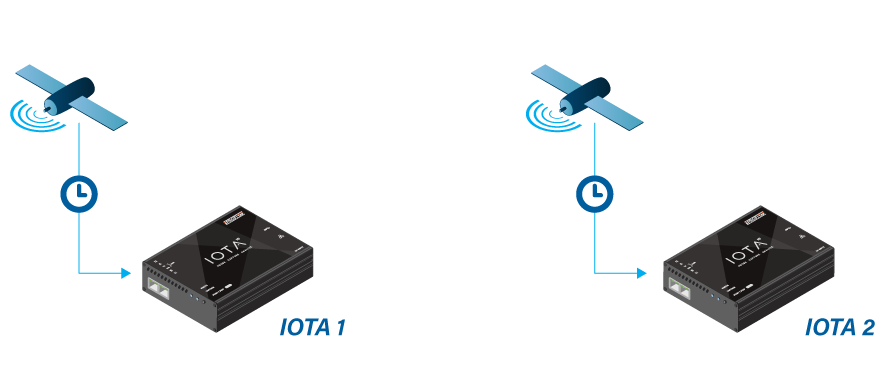Table of Contents
Timing analysis
Timestamping is an important tool when analyzing network traffic. All IOTA models are able to timestamp ingress frames using a hardware time counter. The time counter has a resolution of <10 ns, the resolution depends on the device and feature: 8 ns for the 1G and 1G+, 6.4 ns for the 10G, and 5 ns for the 10G+.
In this article, we will show three methods for synchronizing two IOTA devices: with one GPS signal, with two GPS signals, and without GPS signal.
Method 1: relying on one GPS signal
Let’s get started with two key definitions. Time initialization means taking a timestamp from a source. This happens once during IOTA boot time. Counter disciplining means synchronizing the counter speed to an external source. This happens every second during IOTA operation.

IOTA 1's time is initialized from the GPS signal, and the timestamp counter is disciplined from the GPS. In this case, IOTA 1 is the “main” device, disciplining IOTA 2.
IOTA 2 uses its own system time (set either via NTP or manually), while the timestamp counter is disciplined from external PPS (from IOTA 1).
For this method, it is important that IOTA 2's system time be within 0.5 s of UTC global time.
If IOTA 2's system time has an offset greater than 0.5 s, this may induce a constant time offset between IOTA 1 and IOTA 2 (aligned to whole seconds, like 1 s, 2 s, etc).
Benefits of this method:
- It measures delay between packets within IOTA 1 and the same packets within IOTA 2 (as clocks are synchronized).
- It makes it possible to run timestamp analysis even if there is no possibility to use GPS on IOTA 2 (no signal or weak signal).
Method 2: relying on two GPS signals

Times are initialized from GPS and timestamp counters are disciplined from GPS.
In this case, both IOTAs rely on GPS signals in both taking timestamps and disciplining. Therefore, both IOTAs will have valid absolute UTC-aligned timestamps.
Benefits of this method:
- It measures precise packet delays between IOTAs.
- There is no distance limit, no matter how geographically separated the capture point locations are.
Method 3: no GPS signal

To synchronize two IOTAs together (not to UTC) without GPS signal, both IOTAs use their own system time for timestamping (the “0.5 seconds difference” rule mentioned above also applies here). IOTA 1 generates a PPS signal and forwards it to IOTA 2 through a PPS cable.
Alternatively, an external PPS source can provide PPS to both IOTAs.
Benefits of this method:
- Relative (not UTC-aligned) delay measurements between and within IOTAs.
- An effective way to run a timestamp analysis if there is no possibility to use GPS.